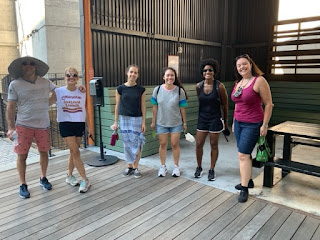This Week's Tour...
...met at 9:00AM Saturday on the Beltline Eastside Trail near Parish (R.I.P...soon to reopen as "Painted Park"!). We walked for 1 1/2 hours, covering 1 mile of the Beltline, ending at Ponce City Market.
"The Tourists"...
...shouting out to this week's tourists, recent Dawsonville residents (2 not pictured) recently relocated from Houston. Welcome to the ATL!
Map of the week...
...is really an aerial photo of the Atlanta Crackers stadium, Ponce de Leon Park (built 1905, destroyed by fire 1923, rebuilt 1924). This photo is undated, but it shows both the Sears Building (1926) and the Ford Factory (1914)...so it is the "new" concrete and steel ballpark sometime between 1927 and 1964. I included a street level pic from the 1950's.
I'm geeking out about a couple of things in these photos:
- The aerial photo shows the original rail spur going into the courtyard of Sears, not just stopping alongside it (like we experience today in the "Shed").
- The 1950's photo shows cards and overhead streetcar power lines...but no trolly tracks. If there is still a "streetcar", could it be an electric bus? The original streetcar on this route was number #2. The current MARTA bus route today? Also #2!
- Notice the Sears sign in the street photo...PCM designed their new sign to follow that same design!
Tree of the week...
...singling out one of the hundreds of specimens from the dozens of collections along the arboretum.
The Georgia oak is native to the southeastern United States, mainly in northern Georgia, but with additional populations in Alabama, North Carolina, and South Carolina. It grows on dry granite and sandstone outcrops of slopes of hills at 50–500 meters (160–1,640 ft) altitude.
The tree was first discovered in 1849 at Stone Mountain, Georgia, where several stands of pure specimens grow along the popular walk-up trail at around 1,300 feet (near the large chestnut oak in the middle of the trail and before the rest pavilion halfway up the trail). Georgia oaks are also found at nearby monadnocks, including Panola Mountain and Arabia Mountain in Georgia.
"Stump" of the week...
...featuring a question raised during the tour that Jeff couldn't answer.










